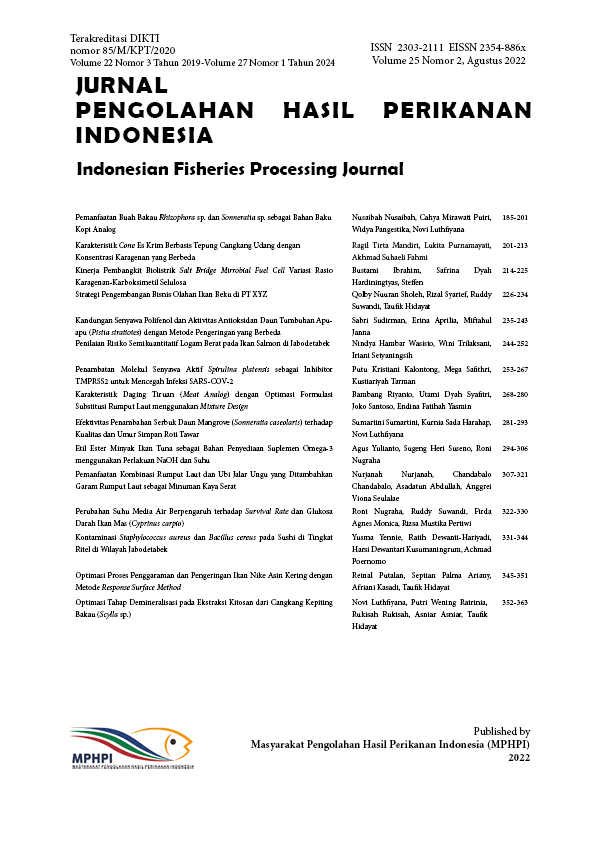Karakteristik Daging Tiruan (Meat Analog) dengan Optimasi Formulasi Substitusi Rumput Laut menggunakan Mixture Design Characteristics of Meat Analog with Formula Optimization of Seaweed Substitution using Mixture Design
Abstract
Meat analogues or alternative meats based on vegetable protein have given consumers preference for the importance of health. The natural potential with the characteristics of seaweed offers a new perspective on meat analogues. The design and formulation strategy becomes important. This study was aimed to determine the meat analogue by optimizing the seaweed substitution formulation using mixture design. The research includes characterization of ingredients, manufacture of meat analog and optimization of seaweed substitution formula using mixture design and characterization of seaweed substituted meat analogs. The optimal formula using a mixture design resulted in substitution of 45% seaweed flour with 40% soybean flour and 15% corn flour. Meat analog with optimization of seaweed substitution formulation has the shape of a burger with a diameter of 5 cm, a thickness of 2 cm and a weight of 50 g, sensory appearance of fibrous, yellowish brown color and a distinctive taste of meat. Texture characteristics with a hardness value of 2,385.90 0.02 gf, springiness 0.83±0.01, chewiness 1.52±0.02 and water holding capacity 6.19±0.04 and a protein content of 10.16%±0.01, carbohydrates 46.79%±0.03 and ash 2.50%±0.02, which resembles commercial meat analogs and complies with SNI 8503-2018 for burgers.
References
Angelis, D. D., Kaleda, A., Pasqualone, A., Vaikma, H., Tamm, M., Tammik, M. L., Squeo, G., & Summo, C. (2020). Physicochemical and sensorial evaluation of meat analogues produced from dry-fractionated pea and oat proteins. Foods, 9, 2-15.
Association of Official Analytical Chemist. (2005). Official Methods of Analysis of The Association of Official Analytical Chemists.
Badan Standardisasi Nasional. (2018). Burger Daging. SNI-8503-2018.
Beniwal, A. S., Sigh, J., Kaur, L., & Hardacre, A. (2020). Meat analogs: Protein restructuring during thermomechanical processing. Food Science Journal, 20, 1221-1249.
Bohrer, B. M. (2019). An investigation of the formulation and nutritional composition of modern meat analogue products. Food Science and Human Wellness, 8(4), 320-329.
Boukid, F. (2020). Plant based meat analogues from niche to mainstream. European Food Research and Technology, 1-12.
Cofrades, S., Benedi, J., Garcimartin, A., Sanchez, M. F. J., & Colmenero, F. J. (2017). A comprehensive approach to formulation of seaweed-enriched meat products: from technological development to assessment of healthy properties. Food Research International, 99, 1084-1094.
do Carmo, C. S., Knutsen, S. H., Malizia, G., Dessev, T., Geny, A., Zobel, H., Myhrer, K. S., Varela, P., & Sahlstrøm, S. (2021). Meat analogues from a faba bean concentrate can be generated by high moisture extrusion. Future Foods, 3,100014.
Fiorentini, M., Nolden, A. A., & Kinchala, A. J. (2020). Role of Sensory evaluation in plant-based meat analogs and meat extenders: A scoping review. Foods, 9, 2-15.
Jatav, A. K., & Bhatt, D. K. (2020). Development and evaluation of protein rich extruded puffed product using corn, rice, and soy protein isolate flour. Plant Archives Food Technology, 20(2), 1718-1721.
Kyriakopoulou, K., Keppler, J. K., & Goot, A. T. J. V. (2021). Functionality of ingredients and additives in plant based meat analogues. Foods Journal, 10, 600.
Nunez, B. N., Sahagun, M., & Gomez, M. (2020). Optimisation of protein-enriched gluten-free layer cakes using a mixture design. International Journal of Food Science and Technology, 55, 2171–2178.
Onwezen, M. C., Bouwman, E. P., Reinders, M. J., & Dagevos, H. (2021). A systematic review on cosumer acceptance of alternative proteins: Pulses, algae, insects, plant based meat alternative, and cultured meat. Journal Appetite, 159, 2-57.
Samard, S., & Ryu, G. H. (2018). A comparison of physicochemical characteristics, texture, and structure of meat analogue and meats. Journal Food Science Agricultural. 99, 2708–2715.
Samard, S., & Ryu, G. H. (2019). Physicochemical and functional characteristics of plant protein based meat analogs. Journal Food Processing Preservation, 10,1-11.
Schreuders, F. K. G., Dekkers, B. L., Bodnár, I., Erni, P., Boom, R. M., & van der Goot, A. J. (2019). Comparing structuring potential of pea and soy protein with gluten for meat analogue preparation. Journal of Food Engineering, 261, 32-39.
Sun, A., Wu, W., Soladoye, O. P., Aluko, R. E., Bak, K. H., Fu, Y., & Zhang, Y. (2022). Maillard reaction of food-derived peptides as a potential route to generate meat flavor compounds: A review. Food Research International, 151, 110823.
Wi, G., Bae, J., Kim, H., Cho, Y., & Choi M, J. (2020). Evaluation of the physicochemical and structural properties and the sensory characteristics of meat analogues prepared with various non-animal based liquid additives. Foods, 9, 2-19.
Zhang, T., Dou, W., Zhang, X., Zhao, Yu., Zhang, Y., Jiang, L. Z., & Sui, X. (2021). The development history and recent updates on soy protein-based meat alternatives. Trends in Food Science & Technology, 109, 702-710.
Zhou, Y., & Yang, H. (2019). Effect of calcium ion gel properties and gelation of tilapia (Oreochromis niloticus) protein isolates processed with pH shift method. Food Chemistry, 277, 327 - 335.
Authors

This work is licensed under a Creative Commons Attribution 4.0 International License.
Authors who publish with this journal agree to the following terms:
- Authors retain copyright and grant the journal right of first publication with the work simultaneously licensed under a Creative Commons Attribution License that allows others to share the work with an acknowledgement of the work's authorship and initial publication in this journal.
- Authors are able to enter into separate, additional contractual arrangements for the non-exclusive distribution of the journal's published version of the work (e.g., post it to an institutional repository or publish it in a book), with an acknowledgement of its initial publication in this journal.





